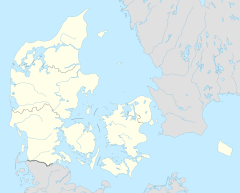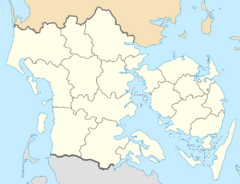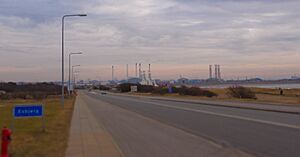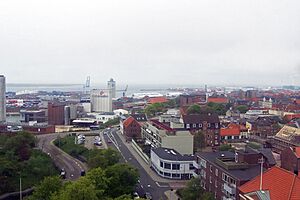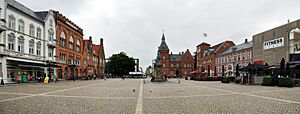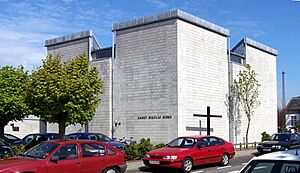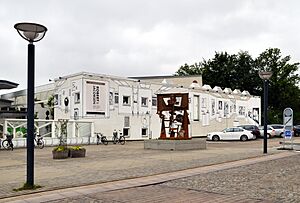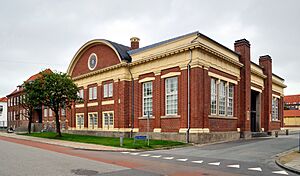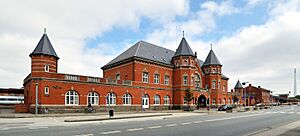Esbjerg facts for kids
Quick facts for kids
Esbjerg
|
||
|---|---|---|
|
Esbjerg harbour, aerial view of the city.
|
||
|
||
| Country | Denmark | |
| Region | Southern Denmark (Syddanmark) | |
| Municipality | Esbjerg | |
| Established | 1868 | |
| City charter | 1899 | |
| Current municipality | 1 January 2007 | |
| Area | ||
| • Urban | 43.7 km2 (16.9 sq mi) | |
| Elevation | 11 m (36 ft) | |
| Population
(1 January 2024)
|
||
| • Urban | 71,505 | |
| • Urban density | 1,636.3/km2 (4,238/sq mi) | |
| • Municipal | 115,459 | |
| • Gender | 35,804 males and 35,701 females | |
| Demonym(s) | Esbjergenser | |
| Time zone | UTC+1 (CET) | |
| • Summer (DST) | UTC+2 (CEST) | |
| Postal code |
6700-6715
|
|
| Area code(s) | (+45) 7 | |
| Website | www.esbjerg.dk | |
Esbjerg is a busy seaport city in southwest Denmark. It's located on the west coast of the Jutland peninsula. Esbjerg is about 71 kilometers (44 miles) west of Kolding. It is Denmark's fifth-largest city, with a population of over 71,500 people. It is also the biggest city in West Jutland.
Before 1868, Esbjerg was just a few farms. Then, a decision was made to build a harbor there. This harbor is now the second largest in Denmark. The city grew very fast after that. By 1901, about 13,000 people lived there. Today, it's a major center for fishing, shipping, and agricultural exports. Esbjerg is also important for the wind-turbine industry. The harbor is growing to support this industry. You can fly to Aberdeen, Scotland, and Stavanger, Norway, from Esbjerg Airport.
The city has many interesting places to visit. These include the Esbjerg Art Museum and the Fisheries and Maritime Museum. The Esbjerg Performing Arts Centre is a modern building for shows. Near the sea, you can see the Man Meets the Sea sculpture. It has four huge white figures looking out over Sædding Beach. Esbjerg is also home to parts of the University of Southern Denmark and Aalborg University. It's known for its sports, too. The city has a football club, Esbjerg fB, and an ice hockey team, Esbjerg Elite Ishockey.
Contents
History of Esbjerg and Its Economy
Esbjerg was founded in 1868. It was built to replace the harbor in Altona. Altona was Denmark's main North Sea port. But it came under German control in 1864. At first, Esbjerg was just a few farms. The harbor officially opened in 1874. It had train connections to Varde and Fredericia. The town was planned with straight streets like a grid. The main square, Torvet, was in the middle.
Esbjerg grew quickly. In the early 1870s, only 400 people lived there. By 1890, the population was over 4,200. In 1899, Esbjerg became an official market town. Important buildings like the courthouse and town hall were built.
From the early 1900s, Esbjerg became a major export center. It was not just a fishing port. Factories for butter and eggs sent products to places like London. After World War II, the city developed more industries. These included meat processing plants.
The Port of Esbjerg is still very important for the city's economy. Esbjerg is a main center for Denmark's oil and offshore activities. Many companies involved in oil and gas have offices here. The port has been vital for the offshore industry since the 1970s. It has also become a hub for shipping offshore wind turbines. Esbjerg handles a large part of all Danish wind turbines. To prepare for more wind power, the port was expanded in 2013. This new area is called the Østhavn (East Harbour).
Esbjerg has also become an important place for education. It has campuses of the University of Southern Denmark and Aalborg University. The city hosts an annual music festival in August. It features different types of music, from classical to pop.
Geography and Climate of Esbjerg
Esbjerg is located on Denmark's southwest coast. It is a port city on the North Sea. The city is 71 km (44 mi) west of Kolding. It is also 164 km (102 mi) southwest of Aarhus. The older parts of the city have a grid-like street plan. This means long, wide streets with rectangular corners.
Esbjerg is on high ground along the east coast of the Wadden Sea. The Wadden Sea is a UNESCO World Heritage Site. Across Fanø Bay from Esbjerg is the island of Fanø. You can take a ferry from Esbjerg to Fanø. The highest point in Esbjerg is about 25 meters (82 feet) above sea level. The city itself is not very hilly. But there are some big differences in the land. For example, there's a cliff in the town park that overlooks the harbor.
Esbjerg's Climate
Esbjerg has an oceanic climate. This means it has warm summers and mild winters. This is because it is right next to the North Sea. The sea's currents help keep the weather mild all year round.
| Climate data for Esbjerg (Sædenstrand) 1961–1990 | |||||||||||||
|---|---|---|---|---|---|---|---|---|---|---|---|---|---|
| Month | Jan | Feb | Mar | Apr | May | Jun | Jul | Aug | Sep | Oct | Nov | Dec | Year |
| Record high °C (°F) | 9.2 (48.6) |
10.9 (51.6) |
17.3 (63.1) |
23.4 (74.1) |
29.1 (84.4) |
32.3 (90.1) |
32.8 (91.0) |
35.2 (95.4) |
29.8 (85.6) |
22.0 (71.6) |
13.8 (56.8) |
10.4 (50.7) |
35.2 (95.4) |
| Mean daily maximum °C (°F) | 2.5 (36.5) |
2.7 (36.9) |
5.1 (41.2) |
9.5 (49.1) |
15.0 (59.0) |
18.2 (64.8) |
19.2 (66.6) |
19.8 (67.6) |
16.6 (61.9) |
12.6 (54.7) |
7.6 (45.7) |
4.2 (39.6) |
11.1 (52.0) |
| Daily mean °C (°F) | 0.7 (33.3) |
0.7 (33.3) |
2.7 (36.9) |
6.1 (43.0) |
11.1 (52.0) |
14.4 (57.9) |
15.9 (60.6) |
16.1 (61.0) |
13.5 (56.3) |
10.0 (50.0) |
5.6 (42.1) |
2.4 (36.3) |
8.3 (46.9) |
| Mean daily minimum °C (°F) | −1.3 (29.7) |
−1.6 (29.1) |
0.3 (32.5) |
3.0 (37.4) |
7.5 (45.5) |
11.2 (52.2) |
12.9 (55.2) |
12.9 (55.2) |
10.5 (50.9) |
7.4 (45.3) |
3.4 (38.1) |
0.3 (32.5) |
5.6 (42.1) |
| Record low °C (°F) | −16.6 (2.1) |
−16.6 (2.1) |
−13.0 (8.6) |
−5.2 (22.6) |
−1.0 (30.2) |
2.7 (36.9) |
5.6 (42.1) |
4.0 (39.2) |
0.0 (32.0) |
−2.3 (27.9) |
−12.0 (10.4) |
−16.0 (3.2) |
−16.6 (2.1) |
| Average precipitation mm (inches) | 60 (2.4) |
41 (1.6) |
48 (1.9) |
40 (1.6) |
47 (1.9) |
55 (2.2) |
60 (2.4) |
72 (2.8) |
82 (3.2) |
94 (3.7) |
88 (3.5) |
72 (2.8) |
759 (29.9) |
| Average snowy days | 6.9 | 5.7 | 4.9 | 2.0 | 0.0 | 0.0 | 0.0 | 0.0 | 0.0 | 0.1 | 1.8 | 5.4 | 27.0 |
| Source: Danish Meteorological Institute | |||||||||||||
Population and Local Government
As of 2019, Esbjerg has a population of over 72,000 people. This makes it the fifth-largest city in Denmark. Before the harbor was built in the 1860s, only a few people lived here. But the population grew very fast. By 1901, it was already bigger than nearby towns. By the late 1950s, almost 60,000 people lived in Esbjerg.
The city council of Esbjerg has 31 members. The mayor is Jesper Frost Rasmussen. He is from the Venstre, Liberal Party. The council has different committees. These committees help manage things like finance, health, and culture.
Mayors of Esbjerg Since 1898
Here are some of the people who have been mayor of Esbjerg:
- 1898–1907: Jørgen Lyngbye
- 1907–1921: Knud Holch
- 1921–1925: A.P. Brandholt
- 1925–1929: Niels Jørgen Jæger
- 1929–1941: Morten Mortensen
- 1941–1942: Rasmus Peder Nielsen Kock
- 1942–1950: Laurits Høyer-Nielsen
- 1950–1954: Hans Nissen
- 1954–1958: Laurits Høyer-Nielsen
- 1958–1959: Hans Nissen
- 1959–1964: Laurits Høyer-Nielsen
- 1964–1979: Henning Rasmussen
- 1979–1989: Alfred Kristian Nielsen
- 1990–1993: Flemming Bay-Jensen
- 1994–2019: Johnny Søtrup
- 2019– : Jesper Frost Rasmussen
Famous Landmarks in Esbjerg
The old Courthouse is on the main square. It was built in 1892. This red-brick building looks like a medieval castle. It has a tower that is 30 meters (98 feet) tall. After being fixed up in 2010, it is now used for weddings and the tourist office.
Man Meets the Sea is a huge sculpture. It has four white figures, each 9 meters (27 feet) tall. They stand west of Esbjerg, looking out over Sædding Beach. This sculpture was put up in 1995. It celebrates the city's 100th birthday. You can see it when leaving or entering Esbjerg by ferry.
The Esbjerg Water Tower was built in 1895. It stands on top of a cliff. From its platform, you can see great views of the city and harbor. The old courthouse on the main square has a tall tower. A bronze statue of King Christian IX is in the center of the square. He was the founder of Esbjerg.
Hotel Britannia is the largest hotel in Esbjerg. Other hotels include Cabinn and Hotel Ansgar. Many restaurants are located east of the main square. You can find Danish food like smørrebrød (open-faced sandwiches) at places like Sand's Restaurant.
Churches in Esbjerg
The first church in Esbjerg was the Church of Our Saviour. It was built in 1887 with red bricks. Later, it was made bigger to hold more people. After World War II, more churches were built as the city grew.
The yellow-brick Trinity Church has large, colorful windows. It was designed to have a big space for people. It also has rooms for meetings and activities. Its bell tower stands separately from the main church building.
St Nikolaj is a Roman Catholic church. It was built in 1969. It's unusual because it's made of aerated concrete. Its square shape was designed by Johan Otto von Spreckelsen. This design later inspired his famous Grande Arche in Paris.
The modern red-brick Grundtvig's Church was finished in 1969. It has a unique, strangely shaped red-tiled roof. Inside, the walls are mostly plain. Light comes in from narrow windows and a bright tower room.
Sædden Church was opened in 1978. It has wave-like folds in its red-brick walls. Light from 803 light bulbs brightens the altar. Gjesing Church, built in 1983, also has a separate bell tower. Other churches include Zion's Church and Jerne Church. The Bethania Mission House was built in 1906. It looks similar to the old churches.
Museums and Theatres in Esbjerg
Esbjerg has many museums, libraries, and places for music and plays. The Esbjerg Performing Arts Centre (Musikhuset Esbjerg) has two main halls. Its concert hall can hold over 1,100 people. It hosts classical concerts, opera, and plays. It was completed in 1997. It is next to the Esbjerg Art Museum (Esbjerg Kunstmuseum). This museum shows art from artists like Asger Jorn. It also has international exhibitions.
The Fisheries and Maritime Museum opened in 1968. It has an aquarium with saltwater fish and seals. It also shows exhibitions about Danish fishing and shipping. The Esbjerg Museum in the city center tells the history of Esbjerg. It has displays from the Iron Age and the Viking Age. You can also see a large collection of amber.
The Printing Museum shows how printing has changed over time. It has old machines used to print books and newspapers. The Lightship Museum is in the harbor. You can go on board the Horns Rev lightship. This ship is from 1912. It is the oldest and best-preserved motor lightship in the world. It shows what life was like on board.
Education in Esbjerg
Esbjerg is an important city for education. It has campuses of the University of Southern Denmark and Aalborg University. There is also an IT Academy West branch. The main part of Profession School – University College West is here. The Esbjerg section of the Academy of Music and Dramatic Arts is also in the city. It is located in an old power station. The Southwest Jutland Hospital is in Esbjerg. It treats many patients each year.
Sports in Esbjerg
Esbjerg is home to the Danish football club Esbjerg fB. They are also known as EfB. The club has won the Danish Championship five times. They play their home games at Blue Water Arena. This stadium is part of the Esbjerg Sports Park.
Esbjerg also has an ice hockey team called Esbjerg Elite Ishockey. They play at the Granly Hockey Arena. This arena was built in 1976. It can hold over 3,400 people. In 2011, it hosted the 2011 Capital One World Women's Curling Championship.
Rugby is played in Esbjerg by the Esbjerg RK team. They play at Guldager Idrætscenter.
Esbjerg also has a motorcycle speedway team. They are called Esbjerg Vikings. They have won the Danish League Championship 11 times. Their home track is the Granly Speedway Arena.
Transport in Esbjerg
Esbjerg is a big transport hub. It has important connections for trains and roads. It is also a key port for Denmark's North Sea oil activities. Esbjerg Airport has flights to Aberdeen, Humberside, and Stavanger. The nearby Billund Airport offers even more flight options.
Esbjerg railway station is the main train station. It is the end point for InterCity trains from Copenhagen. These trains run once an hour. The journey takes about three hours. Local trains also run to Fredericia, Ribe, Tønder, and Struer. The city also has smaller train stops like Gjesing, Jerne, and Spangsbjerg.
Ferry services connect Esbjerg to Nordby on the island of Fanø. This route goes across Ho Bugt. From 1875 to 2014, there was a passenger ferry service across the North Sea to Harwich, England. This service stopped in 2014. But a freight service still runs from Esbjerg to Immingham.
The Port of Esbjerg is the second largest harbor in Denmark. It is home to Maersk Drilling headquarters. It also handles the ferry service between Esbjerg and Fanø. For small boats, there is a marina with 198 places to dock. A new part of the harbor, the Østhavn ("East Harbour"), opened in 2013.
Notable People from Esbjerg
- Hieronymus Georg Zeuthen (1839–1920), mathematician
- Henry Dunker (1870–1962), Swedish businessman
- Harald Salling-Mortensen (1902–1967), architect
- Else Christensen (1913–2005), a leader in modern Paganism
- Camma Larsen-Ledet (1915–1991), politician and mayor
- Poul Nyrup Rasmussen (born 1943), former Prime Minister of Denmark
- Birte Siim (born 1945), political scientist
- Johnny Søtrup (born 1949), politician
- Finn Nørbygaard (born 1952), actor and entertainer
- Lene Buhl-Mortensen (born 1956), marine biologist
- Søren Østergaard (born 1957), actor
- Mette Reissmann (born 1963), politician
- Gregers Brinch (born 1964), composer
- Henrik Olesen (born 1967), artist
- Sonja Richter (born 1974), actress
- Michael Noer (born 1978), film director
Sports Stars from Esbjerg
- Hvitfeldt Hansen (1890–1964), wrestler
- Jens Petersen (1941–2012), football player and manager
- Erik Gundersen (born 1959), motorcycle speedway rider
- Michael Schjønberg (born 1967), football player and manager
- Peter Skov-Jensen (born 1971), footballer
- Allan Nielsen (born 1971), footballer
- Karina Lauridsen (born 1976), Paralympic athlete
- Martin Jensen (born 1978), footballer
- Jerry Lucena (born 1980), Filipino football player and manager
- Henning Bager (born 1981), motorcycle speedway rider
- Niels Kristian Iversen (born 1982), motorcycle speedway rider
- Søren Rieks (born 1987), footballer
- Philip Larsen (born 1989), ice hockey player
- Martin Braithwaite (born 1991), footballer
- Stefan Nielsen (born 1994), British motorcycle speedway rider
- Pernille Sørensen (born 1998), figure skater
Sister Cities
Esbjerg has partnerships with other cities around the world. These are called sister cities. You can find a list of them on the Esbjerg Municipality page.
See also
 In Spanish: Esbjerg para niños
In Spanish: Esbjerg para niños





